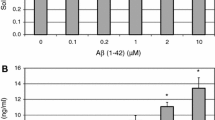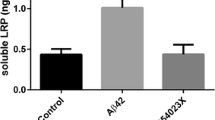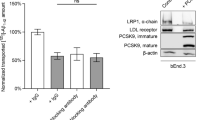Abstract
Lipoprotein receptor transport across the blood-brain barrier (BBB) mediates beta-amyloid (Aβ) accumulation in the brain and may be a contributing factor in Alzheimer’s disease (AD) pathogenesis. Lipoprotein receptors are susceptible to proteolytic shedding at the cell surface, which precludes the endocytic transport of ligands. A ligand that closely interacts with the lipoprotein receptors is apolipoprotein E (apoE), which exists as three isoforms (apoE2, apoE3, apoE4). Our prior work showed an inverse relationship between lipoprotein receptor shedding and Aβ transport across the BBB, which was apoE-isoform dependent. To interrogate this further, the current studies investigated an enzyme implicated in lipoprotein receptor shedding, matrix metalloproteinase 9 (MMP9). Treatment with MMP9 dose-dependently elevated lipoprotein receptor shedding in brain endothelial cells and freshly isolated mouse cerebrovessels. Furthermore, treatment with a MMP9 inhibitor (SB-3CT) mitigated Aβ-induced lipoprotein receptor shedding in brain endothelial cells and the brains of apoE4 animals. In terms of BBB transit, SB-3CT treatment increased the transport of Aβ across an in vitro model of the BBB. In vivo, administration of SB-3CT to apoE4 animals significantly enhanced Aβ clearance from the brain to the periphery following intracranial administration of Aβ. The current studies show that MMP9 impacts lipoprotein receptor shedding and Aβ transit across the BBB, in an apoE isoform-specific manner. In total, MMP9 inhibition can facilitate Aβ clearance across the BBB, which could be an effective approach to lowering Aβ levels in the brain and mitigating the AD phenotype, particularly in subjects carrying the apoE4 allele.









Similar content being viewed by others
References
Reitz C (2012) Alzheimer's disease and the amyloid cascade hypothesis: a critical review. Int J Alzheimers Dis 2012:1–11
Citron M (2010) Alzheimer's disease: Strategies for disease modification. Nat Rev Drug Discov 9(5):387–398
Castellano JM, Kim J, Stewart FR, Jiang H, DeMattos RB, Patterson BW, Fagan AM, Morris JC et al (2011) Human apoE isoforms differentially regulate brain amyloid-beta peptide clearance. Sci Transl Med 3(89):57–67
Mawuenyega KG, Sigurdson W, Ovod V, Munsell L, Kasten T, Morris JC, Yarasheski KE, Bateman RJ (2010) Decreased clearance of CNS beta-amyloid in Alzheimer's disease. Science 330(6012):1774
Selkoe DJ, Hardy J (2016) The amyloid hypothesis of Alzheimer's disease at 25 years. EMBO Mol Med 8(6):595–608
Krohn M, Lange C, Hofrichter J, Scheffler K, Stenzel J, Steffen J, Schumacher T, Bruning T et al (2011) Cerebral amyloid-beta proteostasis is regulated by the membrane transport protein ABCC1 in mice. J Clin Invest 121(10):3924–3931
Castellano JM, Deane R, Gottesdiener AJ, Verghese PB, Stewart FR, West T, Paoletti AC, Kasper TR et al (2012) Low-density lipoprotein receptor overexpression enhances the rate of brain-to-blood Abeta clearance in a mouse model of beta-amyloidosis. Proc Natl Acad Sci U S A 109(38):15502–15507
Storck SE, Pietrzik CU (2017) Endothelial LRP1 - a potential target for the treatment of Alzheimer's disease: theme: drug discovery, development and delivery in Alzheimer's disease guest editor: Davide Brambilla. Pharm Res 34(12):2637–2651
Rebeck GW, LaDu MJ, Estus S, Bu G, Weeber EJ (2006) The generation and function of soluble apoE receptors in the CNS. Mol Neurodegener 1:15–27
Selvais C, Dedieu S, Hornebeck W, Emonard H (2010) Post-translational proteolytic events influence LRP-1 functions. Biomed Mater Eng 20(3):203–207
Kim J, Basak JM, Holtzman DM (2009) The role of apolipoprotein E in Alzheimer's disease. Neuron 63(3):287–303
Bachmeier C, Paris D, Beaulieu-Abdelahad D, Mouzon B, Mullan M, Crawford F (2013) A multifaceted role for apoE in the clearance of beta-amyloid across the blood-brain barrier. Neurodegener Dis 11(1):13–21
Bachmeier C, Shackleton B, Ojo J, Paris D, Mullan M, Crawford F (2014) Apolipoprotein E isoform-specific effects on lipoprotein receptor processing. NeuroMolecular Med 16(4):686–696
Talamagas AA, Efthimiopoulos S, Tsilibary EC, Figueiredo-Pereira ME, Tzinia AK (2007) Abeta(1-40)-induced secretion of matrix metalloproteinase-9 results in sAPPalpha release by association with cell surface APP. Neurobiol Dis 28(3):304–315
Hahn-Dantona E, Ruiz JF, Bornstein P, Strickland DK (2001) The low density lipoprotein receptor-related protein modulates levels of matrix metalloproteinase 9 (MMP-9) by mediating its cellular catabolism. J Biol Chem 276(18):15498–15503
Mantuano E, Inoue G, Li X, Takahashi K, Gaultier A, Gonias SL, Campana WM (2008) The hemopexin domain of matrix metalloproteinase-9 activates cell signaling and promotes migration of schwann cells by binding to low-density lipoprotein receptor-related protein. J Neurosci 28(45):11571–11582
Selvais C, D'Auria L, Tyteca D, Perrot G, Lemoine P, Troeberg L, Dedieu S, Noel A et al (2011) Cell cholesterol modulates metalloproteinase-dependent shedding of low-density lipoprotein receptor-related protein-1 (LRP-1) and clearance function. FASEB J 25(8):2770–2781
Selvais C, Gaide Chevronnay HP, Lemoine P, Dedieu S, Henriet P, Courtoy PJ, Marbaix E, Emonard H (2009) Metalloproteinase-dependent shedding of low-density lipoprotein receptor-related protein-1 ectodomain decreases endocytic clearance of endometrial matrix metalloproteinase-2 and -9 at menstruation. Endocrinology 150(8):3792–3799
Bell RD, Winkler EA, Singh I, Sagare AP, Deane R, Wu Z, Holtzman DM, Betsholtz C et al (2012) Apolipoprotein E controls cerebrovascular integrity via cyclophilin a. Nature 485(7399):512–516
Teng Z, Guo Z, Zhong J, Cheng C, Huang Z, Wu Y, Tang S, Luo C et al (2017) ApoE influences the blood-brain barrier through the NF-kappaB/MMP-9 pathway after traumatic brain injury. Sci Rep 7(1):6649
Halliday MR, Rege SV, Ma Q, Zhao Z, Miller CA, Winkler EA, Zlokovic BV (2016) Accelerated pericyte degeneration and blood-brain barrier breakdown in apolipoprotein E4 carriers with Alzheimer's disease. J Cereb Blood Flow Metab 36(1):216–227
Main BS, Villapol S, Sloley SS, Barton DJ, Parsadanian M, Agbaegbu C, Stefos K, McCann MS et al (2018) Apolipoprotein E4 impairs spontaneous blood brain barrier repair following traumatic brain injury. Mol Neurodegener 13(1):17
Sullivan PM, Mezdour H, Aratani Y, Knouff C, Najib J, Reddick RL, Quarfordt SH, Maeda N (1997) Targeted replacement of the mouse apolipoprotein E gene with the common human APOE3 allele enhances diet-induced hypercholesterolemia and atherosclerosis. J Biol Chem 272(29):17972–17980
Bachmeier C, Beaulieu-Abdelahad D, Crawford F, Mullan M, Paris D (2013) Stimulation of the retinoid X receptor facilitates beta-amyloid clearance across the blood-brain barrier. J Mol Neurosci 49(2):270–276
Bachmeier C, Mullan M, Paris D (2010) Characterization and use of human brain microvascular endothelial cells to examine beta-amyloid exchange in the blood-brain barrier. Cytotechnology 62(6):519–529
Paris D, Bachmeier C, Patel N, Quadros A, Volmar CH, Laporte V, Ganey J, Beaulieu-Abdelahad D et al (2011) Selective antihypertensive dihydropyridines lower abeta accumulation by targeting both the production and the clearance of abeta across the blood-brain barrier. Mol Med 17(3–4):149–162
Cui J, Chen S, Zhang C, Meng F, Wu W, Hu R, Hadass O, Lehmidi T et al (2012) Inhibition of MMP-9 by a selective gelatinase inhibitor protects neurovasculature from embolic focal cerebral ischemia. Mol Neurodegener 7:21
Gu Z, Cui J, Brown S, Fridman R, Mobashery S, Strongin AY, Lipton SA (2005) A highly specific inhibitor of matrix metalloproteinase-9 rescues laminin from proteolysis and neurons from apoptosis in transient focal cerebral ischemia. J Neurosci 25(27):6401–6408
Mayer CA, Brunkhorst R, Niessner M, Pfeilschifter W, Steinmetz H, Foerch C (2013) Blood levels of glial fibrillary acidic protein (GFAP) in patients with neurological diseases. PLoS One 8(4):e62101
Missler U, Wiesmann M, Wittmann G, Magerkurth O, Hagenstrom H (1999) Measurement of glial fibrillary acidic protein in human blood: analytical method and preliminary clinical results. Clin Chem 45(1):138–141
Youmans KL, Tai LM, Nwabuisi-Heath E, Jungbauer L, Kanekiyo T, Gan M, Kim J, Eimer WA et al (2012) APOE4-specific changes in abeta accumulation in a new transgenic mouse model of Alzheimer disease. J Biol Chem 287(50):41774–41786
Tai LM, Balu D, Avila-Munoz E, Abdullah L, Thomas R, Collins N, Valencia-Olvera AC, LaDu MJ (2017) EFAD transgenic mice as a human APOE relevant preclinical model of Alzheimer's disease. J Lipid Res 58(9):1733–1755
Bell RD, Sagare AP, Friedman AE, Bedi GS, Holtzman DM, Deane R, Zlokovic BV (2007) Transport pathways for clearance of human Alzheimer's amyloid beta-peptide and apolipoproteins E and J in the mouse central nervous system. J Cereb Blood Flow Metab 27(5):909–918
Lee JM, Yin K, Hsin I, Chen S, Fryer JD, Holtzman DM, Hsu CY, Xu J (2005) Matrix metalloproteinase-9 in cerebral-amyloid-angiopathy-related hemorrhage. J Neurol Sci 229-230:249–254
Hartz AM, Bauer B, Soldner EL, Wolf A, Boy S, Backhaus R, Mihaljevic I, Bogdahn U et al (2011) Amyloid-beta contributes to blood-brain barrier leakage in transgenic human amyloid precursor protein mice and in humans with cerebral amyloid angiopathy. Stroke 43(2):514–523
Shackleton B, Crawford F, Bachmeier C (2016) Inhibition of ADAM10 promotes the clearance of abeta across the BBB by reducing LRP1 ectodomain shedding. Fluids Barriers CNS 13(1):14
Mizoguchi H, Takuma K, Fukuzaki E, Ibi D, Someya E, Akazawa KH, Alkam T, Tsunekawa H et al (2009) Matrix metalloprotease-9 inhibition improves amyloid beta-mediated cognitive impairment and neurotoxicity in mice. J Pharmacol Exp Ther 331(1):14–22
Bales KR, Liu F, Wu S, Lin S, Koger D, DeLong C, Hansen JC, Sullivan PM et al (2009) Human APOE isoform-dependent effects on brain beta-amyloid levels in PDAPP transgenic mice. J Neurosci 29(21):6771–6779
Schmechel DE, Saunders AM, Strittmatter WJ, Crain BJ, Hulette CM, Joo SH, Pericak-Vance MA, Goldgaber D et al (1993) Increased amyloid beta-peptide deposition in cerebral cortex as a consequence of apolipoprotein E genotype in late-onset Alzheimer disease. Proc Natl Acad Sci U S A 90(20):9649–9653
Acknowledgments
We would like to thank the Roskamp Foundation for their generosity in helping to make this work possible.
Funding
This work was supported by Merit Review award number I01BX002839 from the United States (U.S.) Department of Veterans Affairs (VA) Biomedical Laboratory Research and Development Program. The research in this publication was also supported by the National Institute on Aging of the National Institutes of Health under award number R01AG041971.
Author information
Authors and Affiliations
Corresponding author
Ethics declarations
Conflict of Interest
Dr. Bachmeier is a Research Scientist at the Bay Pines VA Healthcare System, Bay Pines, FL.
Disclaimer
The contents do not represent the views of the U.S. Department of Veterans Affairs or the United States Government. The content is solely the responsibility of the authors and does not necessarily represent the official views of the National Institutes of Health.
Additional information
Publisher’s Note
Springer Nature remains neutral with regard to jurisdictional claims in published maps and institutional affiliations.
Rights and permissions
About this article
Cite this article
Shackleton, B., Ringland, C., Abdullah, L. et al. Influence of Matrix Metallopeptidase 9 on Beta-Amyloid Elimination Across the Blood-Brain Barrier. Mol Neurobiol 56, 8296–8305 (2019). https://doi.org/10.1007/s12035-019-01672-z
Received:
Accepted:
Published:
Issue Date:
DOI: https://doi.org/10.1007/s12035-019-01672-z




